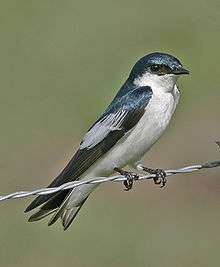White-winged swallow
| White-winged swallow | |
|---|---|
 | |
| White-winged swallow at rest in Los Llanos, Venezuela | |
| Scientific classification | |
| Kingdom: | Animalia |
| Phylum: | Chordata |
| Class: | Aves |
| Order: | Passeriformes |
| Family: | Hirundinidae |
| Genus: | Tachycineta |
| Species: | T. albiventer |
| Binomial name | |
| Tachycineta albiventer (Boddaert, 1783) | |
The white-winged swallow (Tachycineta albiventer) is a resident breeding bird in tropical South America from Colombia, Venezuela and Trinidad south to northern Argentina. It is not found west of the Andes.[2] Being, for the most part non-migratory, stray birds are not often encountered, although there have been sightings. For example, one was once seen on the Tuira River.[3]
Taxonomy and etymology
The new genus Tachycineta was created for this group of swallows by German ornithologist Jean Cabanis in 1850.[4] The current genus name Tachycineta, is from Ancient Greek takhukinetos, "moving quickly", and the specific albiventer is from Latin albus, "white", and venter, "belly".[5]
This swallow is monotypic; it does not have any subspecies.[6]
Description
The adult white-winged swallow is usually about 14 centimetres (5.5 in) long and usually weighs 14–17 grams (0.49–0.60 oz). It has iridescent blue-green upperparts, white underparts and rump, and white edgings to the secondary flight feathers. The wings are otherwise black, along with the tail. It has dark brown eyes and a black bill and legs. The sexes are similar, although it is noted that the females have slightly less white on the wing. Juveniles have grayer underparts and are duller in general when compared to the adults. The juvenile also has less white on the wing.[6][7][8]
White-winged swallows can be distinguished from the similar mangrove swallow by the fact that the white-winged swallow does not have a white line above its lores, and that it has more white on its wing.[8]
Call
The call is a harsh chirrup or a repeated, rising, buzz-like zweeed.[7] Its alarm call is short and harsh. [6][8]
Distribution
The white-winged swallow is native to Argentina, Bolivia, Brazil, Colombia, Ecuador, French Guiana, Guyana, Paraguay, Peru, Suriname, Trinidad and Tobago, and Venezuela. It is vagrant to Panama.[1][9]
Behaviour
Diet
The white-winged swallow usually forages over water, but it has been seen to forage over pastures. In between foraging attempts, it usually perches on branches near bodies of water.[2] Their flight paths are direct and they fly with a flapping flight.[8] They do not usually fly very high.[7]
This particular swallow feeds primarily on flying insects.[7]
Nesting and Breeding
The white-winged swallow is usually found in or near lowland areas along bodies of water such as rivers or lakes. Pairs do not nest together, they instead nest separately. They are reported to be at elevations of about 500 metres (1,600 ft).[7]
This swallow builds a cup nest lined with other birds' feathers and some seed down in a tree hole,[10] between boulders or in man-made structures. They are usually built a few metres above water. The clutch is three to six white eggs. The eggs are usually 17 mm–20 mm × 13 mm–14.6 mm (0.67 in–0.79 in × 0.51 in–0.57 in) and weigh 1.9 grams (0.067 oz).[7][6][8]
Migration
The white-winged swallow is resident in most of its range, although it is migratory in the southernmost part of its range. In Brazil and Argentina, it is only present from approximately mid September to mid April. Where this population winters is not well known, but it is most likely in the Guianas, Venezuela, and Columbia.[8]
Status
The white-winged swallow is classified as "Least Concern" by the IUCN. The justification for this is the fact that this swallow has a very large range, the population seems to be stable, and that there is estimated over 10000 individuals in the wild.[1][9]
References
- 1 2 3 BirdLife International (2012). "Tachycineta albiventer". IUCN Red List of Threatened Species. Version 2013.2. International Union for Conservation of Nature. Retrieved 26 November 2013.
- 1 2 "White-winged Swallow (Tachycineta albiventer)". Retrieved December 4, 2016.
- ↑ AOU (2000)
- ↑ Cabanis, Jean (1850). Museum Heineanum : Verzeichniss der ornithologischen Sammlung des Oberamtmann Ferdinand Heine auf Gut St. Burchard vor Halberstatdt (in German). 1. Halbertstadt: Independently commissioned by R. Frantz. p. 48. Retrieved December 4, 2016.
- ↑ Jobling, James A (2010). The Helm Dictionary of Scientific Bird Names. London: Christopher Helm. pp. 39, 377. ISBN 978-1-4081-2501-4.
- 1 2 3 4 Turner, Angela (2013). del Hoyo, Josep; Elliott, Andrew; Sargatal, Jordi; Christie, David A.; de Juana, Eduardo, eds. "White-winged Swallow (Tachycineta albiventer)". Handbook of the Birds of the World Alive. Barcelona: Lynx Edicions. Retrieved 5 December 2016. (subscription required (help)).
- 1 2 3 4 5 6 Sedgwick, Carolyn. "Overview - White-winged Swallow (Tachycineta albiventer) - Neotropical Birds". Retrieved December 3, 2016.
- 1 2 3 4 5 6 Turner, Angela K; Rose, Chris (1989). Swallows & Martins: An Identification Guide and Handbook. Boston: Houghton Mifflin. ISBN 0-395-51174-7. p103–105
- 1 2 "White-winged Swallow - Tachycineta albiventer - Overview - Encyclopedia of Life". Retrieved December 4, 2016.
- ↑ E.g. of Macrolobium sp. (Greeney & Merino M. 2006)
- American Ornithologists' Union (AOU) (2000): Forty-second supplement to the American Ornithologists' Union Check-list of North American Birds. Auk 117(3): 847–858. DOI: 10.1642/0004-8038(2000)117[0847:FSSTTA]2.0.CO;2
- ffrench, Richard; O'Neill, John Patton & Eckelberry, Don R. (1991): A guide to the birds of Trinidad and Tobago (2nd edition). Comstock Publishing, Ithaca, N.Y.. ISBN 0-8014-9792-2
- Greeney, Harold F. & Merino M., Paúl A. (2006): Notes on breeding birds from the Cuyabeno Faunistic Reserve in northeastern Ecuador. Boletín de la Sociedad Antioqueña de Ornitología 16(2): 46-57. PDF fulltext
- Hilty, Steven L. (2003): Birds of Venezuela. Christopher Helm, London. ISBN 0-7136-6418-5
